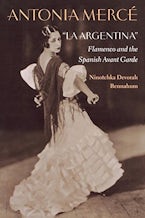- Home
- Wesleyan Dance
- performing arts
- history
- social science
- Antonia Mercé, “LaArgentina”

Antonia Mercé, “LaArgentina”
Flamenco and the Spanish Avant Garde
Series: Wesleyan Dance
Sales Date: 2014-08-26
282 Pages, 7.00 x 10.00 in
The first major study of the Spanish choreographer who invented the modernist Flamenco ballet form.
Antonia Mercé, stage-named La Argentina, was the most celebrated Spanish dancer of the early 20th century. Her intensive musical and theatrical collaborations with members of the Spanish vanguard — Manuel de Falla, Frederico García Lorca, Enrique Granados, Néstor de la Torre, Joaquín Nín, and with renowned Andalusian Gypsy dancers — reflect her importance as an artistic symbol for contemporary Spain and its cultural history. When she died in 1936, newspapers around the world mourned the passing of the "Flamenco Pavlova."
List of Illustrations
Acknowledgements
A Note on Sources
Argentina and Spanish Modernism
The Formative Years (1888-1912)
Giving Grace a Body: From the Music Hall to the Concert Stage (1912-1923)
The Modernism of El amor brujo
A Feminist Folklore: Argentina and the Women of Spain (1910-1936)
Nationalism and Cubism: El fandango del candil and Triana
An Unwritten Legacy
Chronology
Glossary
Notes
Bibliography
NINOTCKA DEVORAH BENNAHUM, choreographer, cultural historian, and native of New Mexico, is an Assistant Professor of Communication Studies, Performance Studies and Theater at Long Island University's Brooklyn Campus. In 1986, she received her doctorate in Performance Studies from New York University's Tisch School of the Arts. In 1991, she founded The Route 66 Dance Company to bring flamenco, modern, and ballet dancers and musicians together. She is contributing editor for Dance Magazine. She writes on ballet and flamenco dance for The Village Voice, the New York Times, the Albuquerque Journal, and elsewhere and teaches dance history for American Ballet Theater's summer intensive program for pre-professional dancers in New York City. She lives in SoHo, New York.
"A richly illuminating work . . . Bennahum has done a noble service by rescuing the great artist Antonia Mercé, known as La Argentina, from the obscurity threatening to overtake her . . . a fascinating, informative, important addition to the library of dance history resources . . . For those of us who love Spanish dance, who have heard vaguely of a great artist named La Argentina, or who thought that the modern ballet had somehow missed Spain until the last decade, this work contains many a revelation."
~Dance Chronicle
""A richly illuminating work . . . Bennahum has done a noble service by rescuing the great artist Antonia Mercé, known as La Argentina, from the obscurity threatening to overtake her . . . a fascinating, informative, important addition to the library of dance history resources . . . For those of us who love Spanish dance, who have heard vaguely of a great artist named La Argentina, or who thought that the modern ballet had somehow missed Spain until the last decade, this work contains many a revelation.""
~Dance Chronicle
""Bennahum has revived the memory of a vital mover and shaker of the dance community; and in doing so she also examines Mercé's role as a feminist and modernist. A fascinating chunk of dance history restored to public eyes.""
~Dance Magazine
""La Argentina is without doubt the most influential Spanish dance artist of this, or any other, century. This is the first serious attempt to evaluate her contribution not only in the strictly dance field, but in the wider context of Spanish culture and the artistic movements of this century. It will be of great value to music and dance historians for its account of La Argentina's long collaboration with Manuel de Falla and its vivid descriptions of some of her important choreographic work, which is all the more valuable in the absence of any notated record.""
~Ivor Guest, author of The Ballet of the Enlightenment
"La Argentina is without doubt the most influential Spanish dance artist of this, or any other, century. This is the first serious attempt to evaluate her contribution not only in the strictly dance field, but in the wider context of Spanish culture and the artistic movements of this century. It will be of great value to music and dance historians for its account of La Argentina's long collaboration with Manuel de Falla and its vivid descriptions of some of her important choreographic work, which is all the more valuable in the absence of any notated record."
~Ivor Guest, author of The Ballet of the Enlightenment




